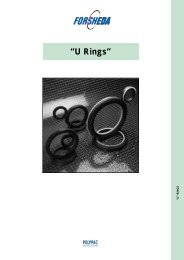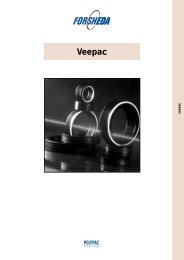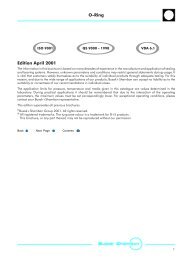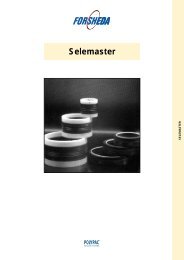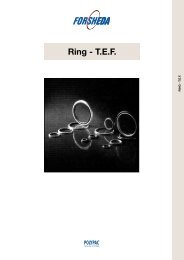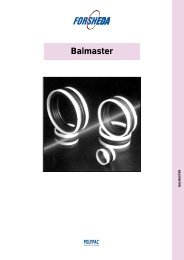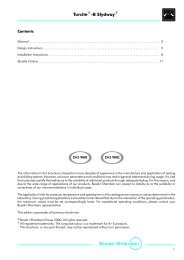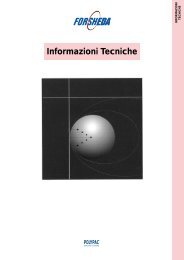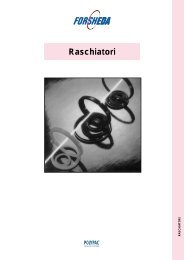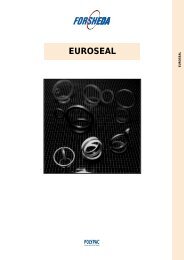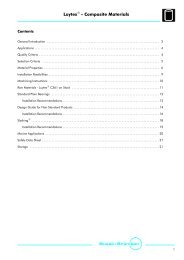Rotary Seals - Dilanda.it
Rotary Seals - Dilanda.it
Rotary Seals - Dilanda.it
Create successful ePaper yourself
Turn your PDF publications into a flip-book with our unique Google optimized e-Paper software.
Cassette Seal<br />
Temperature lim<strong>it</strong>s for seals in typical hypoid oils,<br />
long time use contra short duration load.<br />
Oxidised oils represent another example illustrating the<br />
difficulty of tabulating the oil resistance of rubber<br />
materials. These oils are oxidised during operation and<br />
their properties will therefore change substantially.<br />
-100<br />
NBR<br />
-40 80 150<br />
HNBR<br />
-30<br />
120 170<br />
FKM<br />
-30<br />
100 150 250<br />
-50 0 +50 +100 +150 +200 +250<br />
Temperature °C<br />
= working period of 10.000 hrs<br />
= test against specified oil required<br />
= only for short duration load<br />
Due to the above stated, no detailed information is given<br />
about resistance to certain types of oils. In case of questions<br />
or doubt, <strong>it</strong> is advisable to contact the local B+S office who<br />
have access to the many years of in-house testing made by<br />
FORSHEDA AB. Add<strong>it</strong>ional testing can be carried out in<br />
specific oil types provided a sufficient sample is available.<br />
Chemical resistance<br />
Since the Cassette seals are normally exposed to oil or<br />
grease, and not other chemicals, tables for chemical<br />
resistance to different media are not included. For<br />
guidelines about chemical resistance, please look under<br />
“Radial Oil <strong>Seals</strong>“ or contact your local sales office.<br />
Figure 47 Temperature recommendations in typical<br />
hypoid oils<br />
The temperature lim<strong>it</strong>s for the standard materials in hypoid<br />
oils are illustrated in figure above. They should only be<br />
regarded as approximate, since the oil type and the time of<br />
exposure also affect the materials. The temperature ranges<br />
w<strong>it</strong>hin the shaded areas in the illustrations are<br />
temperatures that can be allowed only for certain<br />
periods of time. The higher the temperature, the shorter<br />
the period of time. At low temperatures, time has no<br />
influence on ageing.<br />
However, seals are not often working in air as only<br />
medium, but they are also affected by other media.<br />
Temperature lim<strong>it</strong>s in combination w<strong>it</strong>h other oils and<br />
media can be obtained from your local sales office.<br />
Oil resistance<br />
Innumerable types of oils are available on the market and<br />
each of these has a different effect on the rubber. In<br />
add<strong>it</strong>ion, a given type of oil from different manufactures<br />
may have a different influence.<br />
n Application<br />
System 500, 3000 and 5000<br />
For the System 500, 3000 and 5000, requirements on the<br />
shaft finish and hardness are less stringent in comparison<br />
w<strong>it</strong>h trad<strong>it</strong>ional radial shaft seals. A simple fine turning<br />
operation gives an adequate surface on the shaft as well as<br />
for the housing bore. Diameter tolerances and finish values<br />
are shown in Figure 49 and 48.<br />
As the sealing elements have built in counterfaces of their<br />
own, no wear on the shaft <strong>it</strong>self will occur and<br />
consequently no hardening of the shaft is necessary.<br />
Su<strong>it</strong>able lead in chamfers facil<strong>it</strong>ates the installation of the<br />
seal.<br />
The add<strong>it</strong>ives in the oil generally affect the rubber. This is<br />
the case w<strong>it</strong>h hypoid oil, which contains sulphur. Since<br />
sulphur is used as vulcanizing agent for N<strong>it</strong>rile rubber, the<br />
sulphur add<strong>it</strong>ive in the oil acts as a vulcanizing agent at<br />
temperatures above +80°C. As a result of this secondary<br />
curing, N<strong>it</strong>rile rubber will rapidly become hard and br<strong>it</strong>tle.<br />
Hydrogenated N<strong>it</strong>rile and Fluorinated rubbers, which are<br />
not vulcanised w<strong>it</strong>h sulphur, can therefore be used for this<br />
type of oil, even though the operating temperature may<br />
not require these.<br />
Latest information available at www.busakshamban.com<br />
Ed<strong>it</strong>ion April 2006<br />
139



